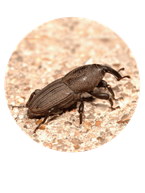The Problem
Armyworms are named after their occasional characteristic of massing like an army and moving en masse across a pasture or turf area devouring plants in their path. A number of armyworms can cause damage in turfgrass including; fall armyworm (Spodoptera frugiperda Smith), lawn armyworm (Spodoptera frugimauritia Boisduval), and armyworm (Pseudalaetia unipuncta Haworth). Fall armyworm is primarily a pest in the southeastern United States, lawn armyworm is limited to Hawaii, and the armyworm (P. unipuncta) is found east of the Rocky Mountains and from British Columbia to Mexico. Even though the fall armyworm is primarily a pest and can survive mild winters only in the Southeast, it often spreads throughout the U.S. depending on late spring weather patterns. The fall armyworm is considered a major turfgrass pest in the southern U.S., feeding primarily on bermudagrass, but it will also feed on fine fescues, ryegrasses and bluegrasses. Armyworm will feed on all grasses and the lawn armyworm feeds only on bermudagrass in Hawaii.
What to Look Out For
Armyworms usually overwinter as eggs and occasionally as larvae. Survival of overwintering stages is highest in the southern U.S., but can also occur during mild winters in the northern U.S. Eggs hatch in the spring and/or larvae emerge and begin feeding. Larvae measure about ¼ inch wide and up to 2 inches long fully-grown. Color of larvae vary with species and food content, and larvae often have a stripe down each side. Larvae pupate into adult moths that are usually dull-colored with wingspans of 13/8 inch to 17/8 inch. Adult moths can migrate for thousands of miles on prevailing winds or large storm fronts. The number of generations per year of each species depends largely on latitude. Four generations of armyworms have been found in Louisiana with larvae as the overwintering stage, five generations in North Carolina, three generations in Ohio, while only two generations are common in New York. Up to 11 generations of fall armyworms have been found in Brownsville, Texas, four generations in Louisiana, and usually only one generation appears in Kansas, New York or Ohio, appearing fairly late in the summer (August-September). With warming global temperatures and occasionally warm seasons from year to year, more generations in a locale may appear in any given year. The fall armyworm is most susceptible to cold, only overwintering in the southernmost states and Mexico.
Adult moths of all armyworm species generally fly at night and are attracted to light, thus black light traps can be used as an accurate monitoring method. Female adults may live for up to five days and can lay clusters of 500 or more eggs in a small area. Larvae hatch and usually feed from dusk to dawn on the underside of leaf blades, often leaving behind the upper clear epidermis layer. Later instars eat the entire leaf, giving the turf a ragged appearance in small, isolated patches. When present in large numbers, armyworms will move together from a decimated turf area to a fresh area. Armyworms tend to prefer wet areas and may become locally problematic after flooding. Mild winter temperatures maximize larval and egg survival, and ensuing damp springs can favor armyworm outbreaks. Generally, the second or third generation is the most damaging and when armyworm numbers are highest. Fall armyworms pose the most threat to southern turf, especially within 100 miles of the Gulf Coast. Here, they can over-winter and all life stages can be present throughout the year. Fall armyworms generally reach their highest numbers in July through October in the Gulf States, and turf managers should be especially vigilant during these months.
The Solution
The best solution is to plant species and cultivars resistant to feeding where possible. Endophyte-containing perennial ryegrasses and tall fescues are good examples. Early detection of armyworms is most successful with black light traps. Though black light traps are excellent for monitoring the timing of adult populations, they are not as effective in predicting extent of damage. If damage is seen and armyworms are suspected, a soap solution of one tablespoon of dish soap per gallon of water can be poured onto turf at approximately two gallons/sq. yd. Larvae will usually come to the surface in three to five minutes. Low populations of armyworms will rarely kill turf since their feeding is usually limited to leaves. Irrigation and low rates of fertilization will often help turf recover. However, armyworm feeding can induce additional stress to a turfgrass plant during hot summer weather, and thus can compromise the long-term health of a lawn.
Armyworm larvae can exist in multiple stages, and short-term insecticides may not be effective in controlling later-hatching larvae. Therefore, Tetrino® can be used to provide almost immediate control and 6-8 weeks of residual control depending on application rate. Damage from high populations of armyworms is difficult to mistake, as they literally mow down vegetation across a fairly widespread area. In this case, a quick knock-down product like Tempo® SC Ultra or Tempo WP Ultra will limit damage quickly.
Additional resources
| Solution sheet - Armyworm |









